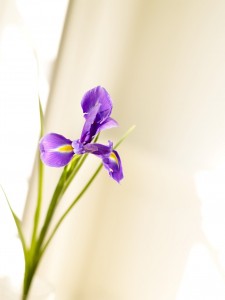Iris
 This flower has connections with ancient Greece, where Iris was the messenger of the Gods, communicating between heaven and earth through a rainbow. The importance of the iris has continued through time and the flowers have had a long association with heraldry and royalty.
This flower has connections with ancient Greece, where Iris was the messenger of the Gods, communicating between heaven and earth through a rainbow. The importance of the iris has continued through time and the flowers have had a long association with heraldry and royalty.
Description
Irises are one of the best-known spring flowers. Their flowers come in a wide variety of colours such a yellow, white and purple, making them a common feature in spring gardens and bouquets. Irises have one flower per stem. Each flower consists of three separate sepals that unfurl as the flower begins to open.
Habitat
The iris grows in the wild in central Asia and northern Afghanistan. In the UK, they are usually grown from bulbs, either as field crops in the winter months or forced into flower in cool rooms in the warmer months.
Availability
Irises flower naturally in the spring months. However, they can be forced at other times, making them available all year round.
Species
The iris belongs to the Iridaceae family, along with freesias. There are some 300 different species of iris, although only a few, such as the Bearded Iris or Dutch Iris, are used as cut flowers.
Care Tips
Bulbs should be planted 10-15cm apart and 80 cm deep in well-drained soil. For the best results, plant the bulbs in a position where the plants will get full exposure to the sun.
After the plants have flowered, a high-potash fertiliser should be used as this will encourage bulb growth. The bulbs should be lifted and separated in the autumn months. This will prevent clumps becoming congested and encourage flowering. Cut flowers should be kept in a cool position. Leaves should be stripped from the lower stem and the stem should then be recut before placing in water.
Did You Know?
The iris genus has a number of natural hybrids that have grown in the wild through cross-pollination.
References
http://www.bbc.co.uk/gardening/plants/plant_finder/plant_pages/5918.shtml
http://apps.rhs.org.uk/advicesearch/Profile.aspx?pid=526


